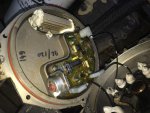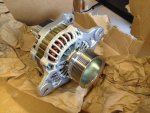clint1
New member
- 2
- 2
- 0
- Location
- Moscow Mills
Two weeks ago I noticed my the side maker lights became much brighter when I started the truck, I looked at the voltmeter on the dash and the needle was in the far right red. I shut the truck off to go get my DVOM to confirm my over charging fears, at 39 volts It did.
The next night I researched the tms to find not much about diagnosing the overcharging regulator.(TM 9-2320-272-23-1 WP0091)I unplugged the alternator wire 568 (ignition wire behind alternator)to stop charging while I brought the truck closer to the house to work on it.
I read on steel soldiers about adjusting the regulator, so I pursued that task of trying that I couldn't find the allen plug to remove to adjust the voltage so I took the regulator off to see what is was going on and to look for fried components. With the regulator off and grounded to the alternator with a jumper wire. I was able to adjust the regulator back to the proper voltage (28.5) with 568 plugged in. It seemed to stay there while during testing in the driveway but when I went to park it the voltmeter was back in the red and as everyone knows how sensitive the ABS ECU is the light was on with a blown 15a fuse. I tried clipping the protection diode to hear that magical sound of a self test with no luck.
I broke down and bought a voltage regulator and an ABS ECU. I put the new regulator on and adjusted it to 28.5v and everything seemed happy. I drove the truck to work the next day (15 miles) and took it to lunch (8 miles) with a sharp eye on the voltmeter. On the way home The voltmeter was back in the red, I pulled over with fear of killing my new ABS ECU and unplugged 568 and went home. I tried adjusting the voltage regulator (with 568 plugged in and ABS fuses pulled) and it was unable to make any voltage adjustments regardless of where the potentiometer was.
I have battery voltage on the harness side of 568 and low voltage drop(<50mv i think)on the ground side. Before I put the new regulator I isolated the batteries and checked for dead cells and found nothing. I think the new regulator is dead but I am afraid of throwing more parts at it. I think there is a broken wire somewhere that I am missing because the problem seems to randomly reappear.
Sorry for being so long winded but I wanted to tell the whole story with the hopes of someone having a problem like this so I can get to the bottom of this.
I attached a photo of my original regulator so other people that would be like me that couldn't find the allen plug on the bottom of the alternator can see where the philips head voltage adjustment pot is without taking the voltage regulator off.

Thanks
The next night I researched the tms to find not much about diagnosing the overcharging regulator.(TM 9-2320-272-23-1 WP0091)I unplugged the alternator wire 568 (ignition wire behind alternator)to stop charging while I brought the truck closer to the house to work on it.
I read on steel soldiers about adjusting the regulator, so I pursued that task of trying that I couldn't find the allen plug to remove to adjust the voltage so I took the regulator off to see what is was going on and to look for fried components. With the regulator off and grounded to the alternator with a jumper wire. I was able to adjust the regulator back to the proper voltage (28.5) with 568 plugged in. It seemed to stay there while during testing in the driveway but when I went to park it the voltmeter was back in the red and as everyone knows how sensitive the ABS ECU is the light was on with a blown 15a fuse. I tried clipping the protection diode to hear that magical sound of a self test with no luck.
I broke down and bought a voltage regulator and an ABS ECU. I put the new regulator on and adjusted it to 28.5v and everything seemed happy. I drove the truck to work the next day (15 miles) and took it to lunch (8 miles) with a sharp eye on the voltmeter. On the way home The voltmeter was back in the red, I pulled over with fear of killing my new ABS ECU and unplugged 568 and went home. I tried adjusting the voltage regulator (with 568 plugged in and ABS fuses pulled) and it was unable to make any voltage adjustments regardless of where the potentiometer was.
I have battery voltage on the harness side of 568 and low voltage drop(<50mv i think)on the ground side. Before I put the new regulator I isolated the batteries and checked for dead cells and found nothing. I think the new regulator is dead but I am afraid of throwing more parts at it. I think there is a broken wire somewhere that I am missing because the problem seems to randomly reappear.
Sorry for being so long winded but I wanted to tell the whole story with the hopes of someone having a problem like this so I can get to the bottom of this.
I attached a photo of my original regulator so other people that would be like me that couldn't find the allen plug on the bottom of the alternator can see where the philips head voltage adjustment pot is without taking the voltage regulator off.

Thanks


